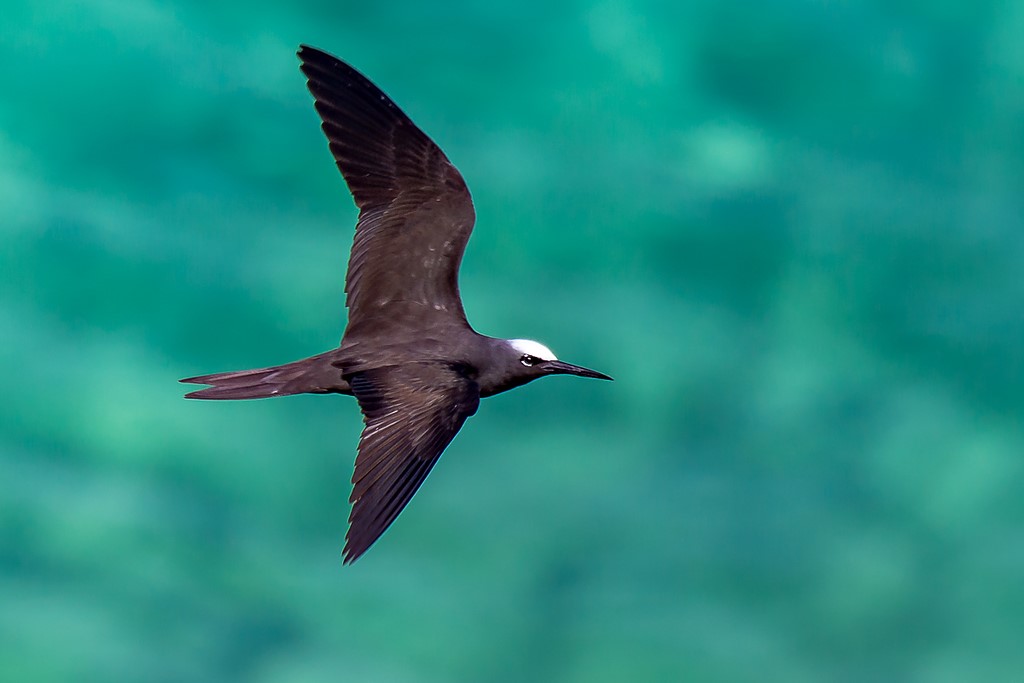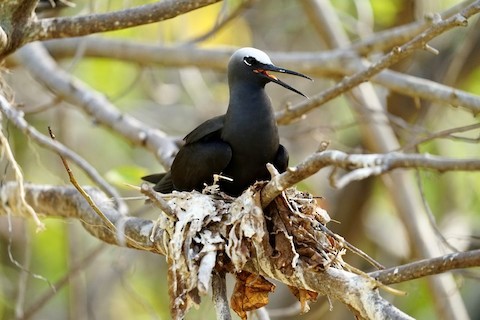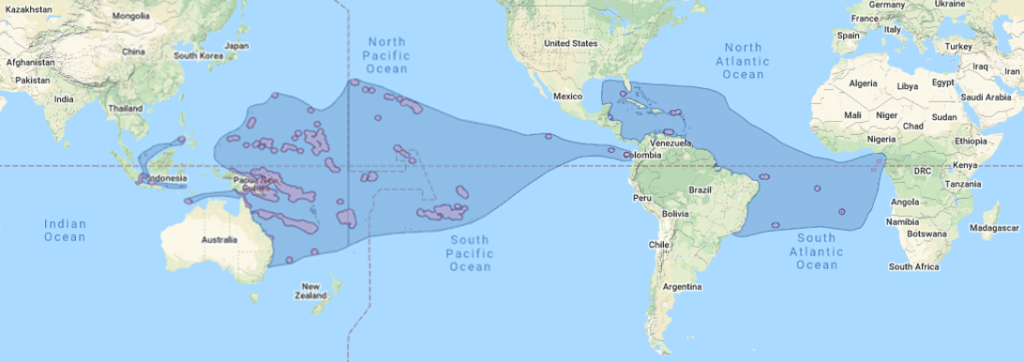Birdfinding.info ⇒ Locally common on and around its remote oceanic nesting islands, but otherwise rare. Accessible sites where the “Atlantic Black Noddy” can be found include Aruba, Fernando de Noronha, and most years one or two at Garden Key in Dry Tortugas National Park. The “Pacific Black Noddy” can be found around many popular resort destinations of the South Pacific including those of Tahiti, Fiji, and Queensland’s Great Barrier Reef. Lone individuals or small groups often appear at various sites along the eastern coast of Australia. The “Hawaiian Noddy” is locally common at certain sites on each of the main islands, including: on Kauai, Ha’ena State Park; on Oahu, Kawainui Regional Park; on Maui, Wai’anapanapa State Park, Ke’anae, and the Oheo Gulch area of Haleakala National Park; and on the Big Island, Pololu, South Point, and the Coastal Chain of Craters Road in Hawaii Volcanoes National Park.
Black Noddy
Anous minutus
Pantropical. Largely resident in its breeding areas, where it nests on either rocky cliffs or trees and forages in both coastal and offshore waters.
Consists of three distinct forms that are perhaps more appropriately regarded as multiple species (for detailed accounts of each, follow the links to their respective pages):
“Atlantic Black Noddy” (americanus and atlanticus): in the southern Caribbean (Venezuela’s Los Roques Archipelago and Aruba’s San Nicolas Reef) and equatorial and South Atlantic: the Brazilian islands of São Pedro e São Paulo, Fernando de Noronha, Trindade, and Martim Vaz; the mid-oceanic British territories Ascension and St. Helena; and in the Gulf of Guinea around São Tomé & Príncipe. Historically also bred at Half Moon Caye, Belize.
“Pacific Black Noddy” (minutus, marcusi, worcesteri, and diamesus): tropical Pacific and adjacent seas, in Micronesia and adjacent archipelagos from the Philippines (Cavilli and Tubbataha Reef), the Marianas, and Marcus Island east to Johnston Atoll and the Northwest Chain of Hawaii, and south to Palau, the Malukus, the Bismarck Sea, and the Marshall Islands; in the far eastern Pacific on Clipperton (Mexico) and Cocos (Costa Rica) Islands; and in the South Pacific from the Timor Sea (west to Adele Island and Ashmore Reef in the northeastern Indian Ocean) east across the Coral Sea, Melanesia, and western and central Polynesia to the Tuamotu Archipelago and Marquesas, south to Lord Howe and Norfolk Islands.
“Hawaiian Noddy” (melanogenys): resident along the coasts of the main Hawaiian Islands from Ni’ihau to the Big Island, where it breeds year-round in small colonies on rocky cliffs and generally remains near breeding areas, feeding mainly in coastal waters. The global population has been estimated at approximately 2,000 pairs.
Identification
A medium-large tern with an exceptionally long, thin bill, mostly black or blackish-brown plumage, and a contrasting white crown. The “Atlantic” and “Pacific” forms are very similar overall, whereas the “Hawaiian” form is strongly differentiated.
On average, “Atlantic” is the darkest and has the most crisply defined white crown. The legs and feet are always black.
Adults in fresh plumage appear almost entirely black or blackish—often detectably browner on the back and wing coverts. Their plumage turns browner with wear, and when heavily worn, it can appear almost entirely brown, or sometimes grayish on the head and neck.
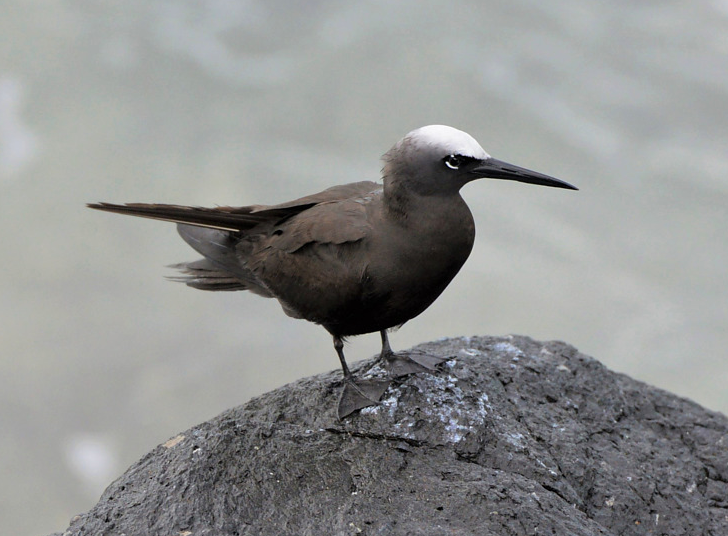
“Atlantic Black Noddy,” A. m. atlanticus. (Fernando de Noronha, Brazil; April 11, 2019.) © Julio Machado

“Pacific Black Noddy,” A. m. marcusi. (French Frigate Shoals, Hawaii; October 20, 2006.) © Cory Gregory
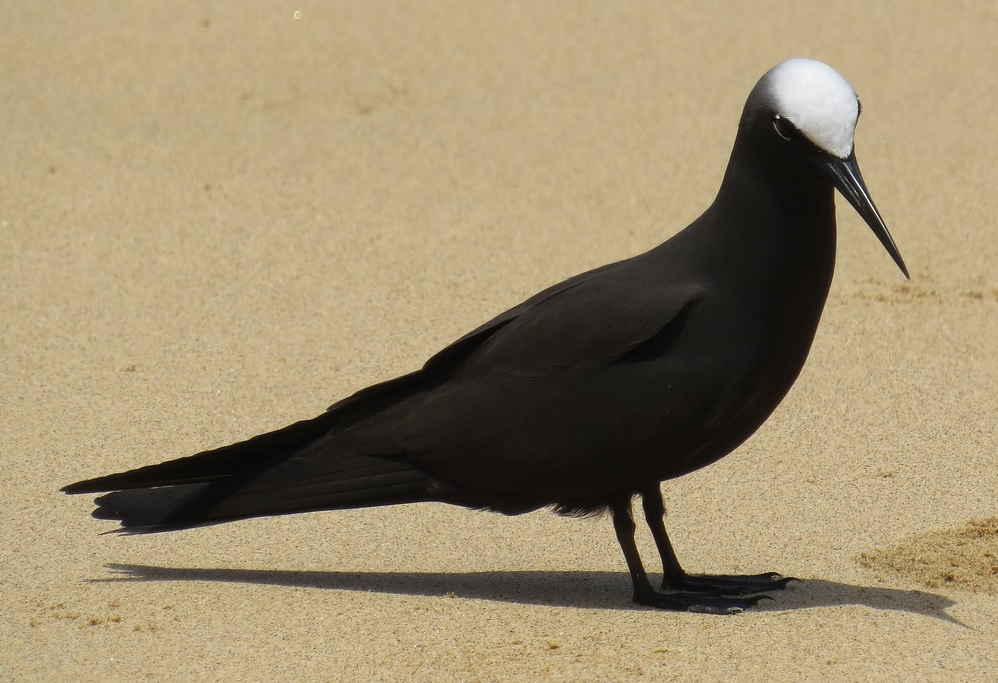
“Atlantic Black Noddy,” A. m. atlanticus. (Fernando de Noronha, Brazil; February 11, 2017.) © Wagner Santana
“Pacific” is somewhat variable. Typical individuals may be indistinguishable from “Atlantic”, but many are somewhat paler, have a more diffuse, less contrasting crown, and have pale feet—e.g., brown, reddish, or orangish.

“Atlantic Black Noddy,” A. m. atlanticus, adult with nestling. (Egg Island, St. Helena; December 16, 2019.) © Allison Miller
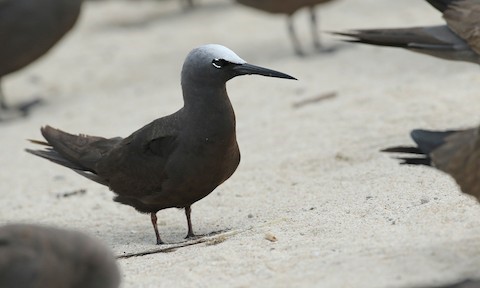
“Pacific Black Noddy,” A. m. minutus. (Michaelmas Cay, Queensland, Australia; March 1, 2016.) © Luke Seitz
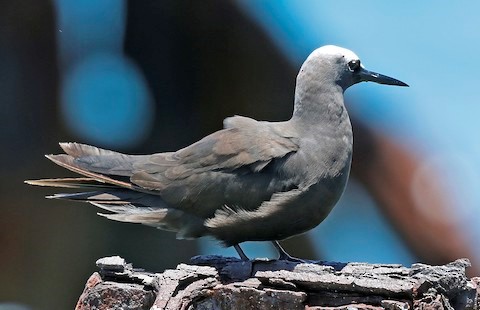
“Atlantic Black Noddy,” A. m. americanus, appearing grayish-brown and bleached-out. (Garden Key, Dry Tortugas National Park, Florida; June 13, 2020.) © Tammy McQuade
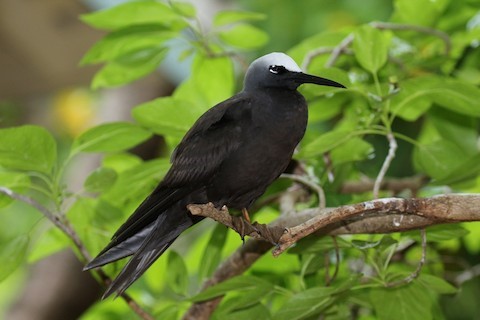
“Pacific Black Noddy,” A. m. minutus. (Heron Island, Queensland, Australia; February 22, 2016.) © Jon Pleizier
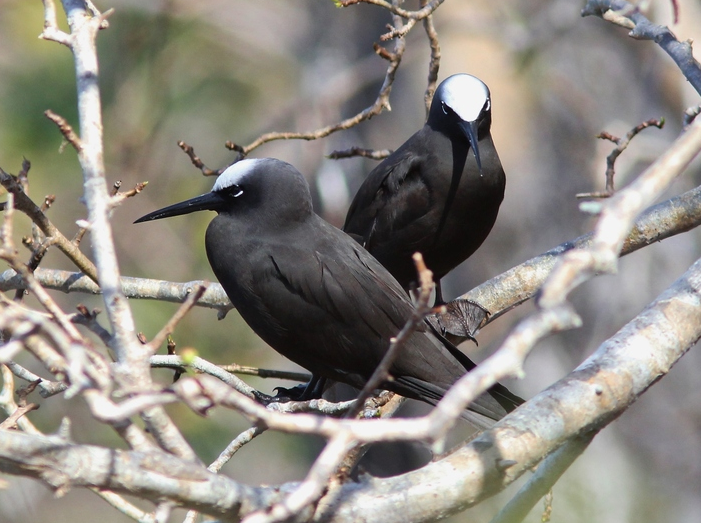
“Atlantic Black Noddy,” A. m. atlanticus. (Fernando de Noronha, Brazil; October 22, 2014.) © Marco Rocha

“Pacific Black Noddy,” A. m. marcusi. (Sand Island, Midway Atoll National Wildlife Refuge, Hawaii; October 11, 2020.) © Atlee Hargis

“Pacific Black Noddy,” A. m. minutus, on nest. (Lady Elliot Island, Queensland, Australia; October 12, 2014.) © Matt Hinze

“Atlantic Black Noddy,” A. m. atlanticus. (Ilha de Maracá do Sul, Amapá, Brazil; December 10, 2015.) © Jackson Cleiton
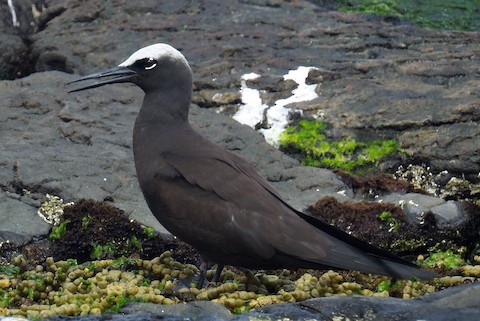
“Pacific Black Noddy,” A. m. minutus. (Flat Rock, Ballina, New South Wales, Australia; March 4, 2018.) © Steven McBride

“Pacific Black Noddy,” A. m. minutus. (Heron Island, Queensland, Australia; December 6, 2020.) © Frank Coman
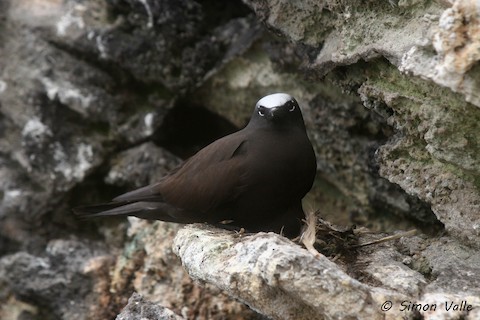
“Atlantic Black Noddy,” A. m. atlanticus. (Tinhosa Grande, São Tomé & Príncipe; February 13, 2013.) © Simon Valle

“Pacific Black Noddy,” A. m. marcusi. (Cocos Island, Guam; March 19, 2017.) © Matthew Bowman
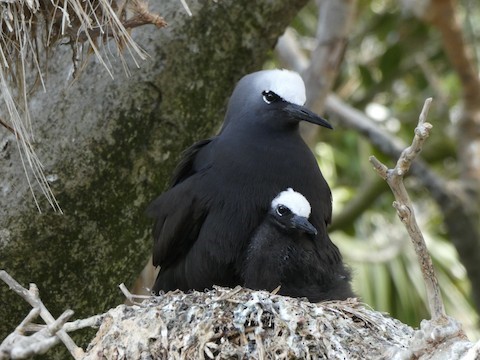
“Pacific Black Noddy,” A. m. minutus, adult with nestling. (Lord Howe Island, Australia; November 19, 2018.) © Allison Turner

“Pacific Black Noddy,” A. m. minutus. (Motu Tapu, Kiribati; August 18, 2019.) © Eric VanderWerf

“Pacific Black Noddy,” A. m. minutus, showing crown coloration more typical of Brown Noddy—but identification confirmed by bill shape. (Lady Elliot Island, Queensland, Australia; March 14, 2020.) © Barry Deacon
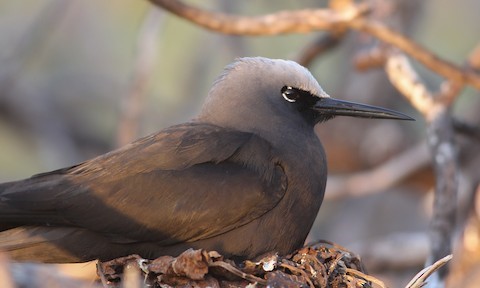
“Pacific Black Noddy,” A. m. marcusi, showing crown coloration more typical of Brown Noddy—but identification confirmed by bill shape. (Laysan Island, Hawaii; November 25, 2011.) © Cameron Rutt
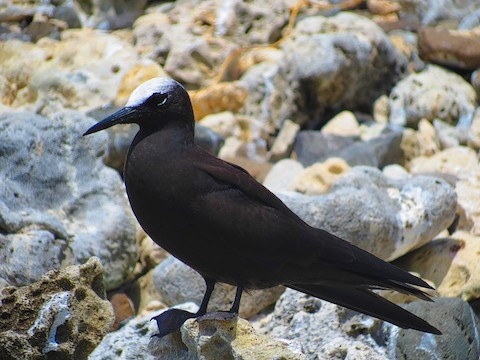
“Pacific Black Noddy,” A. m. minutus. (Lord Howe Island, Australia; February 7, 2013.) © Donna Nagiello
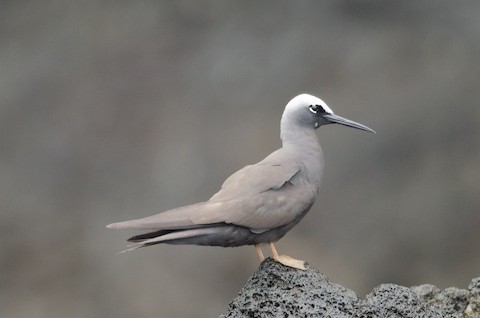
“Pacific Black Noddy,” A. m. minutus—or, based on its orangish feet and pale plumage, it could conceivably be a “Hawaiian Noddy” far out of its normal range. (Lord Howe Island, Australia; March 16, 2012.) © Nige Hartley

“Pacific Black Noddy,” A. m. minutus, at nest with nestling, showing reddish-brown legs. (Lady Elliot Island, Queensland, Australia; December 12, 2020.) © Richard Fuller
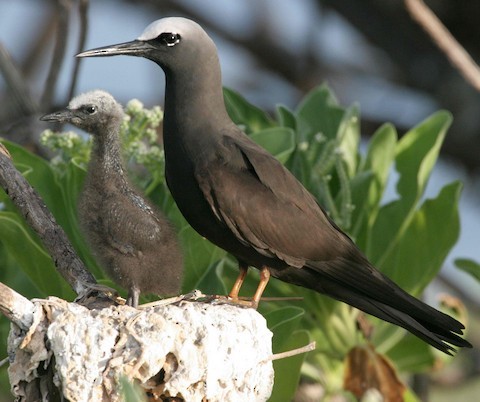
“Pacific Black Noddy,” A. m. minutus, adult with nestling—note adult’s unusually orangish legs, like “Hawaiian Noddy”. (Christmas Island, Kiribati; June 18, 2007.) © Eric VanderWerf
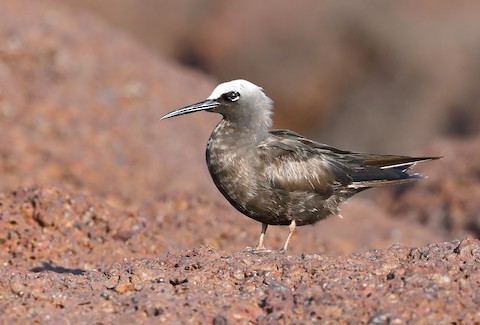
“Pacific Black Noddy,” A. m. minutus, in worn plumage, and with unusually pale legs. (Darwin, Northern Territory, Australia; August 17, 2020.) © Marc Gardner
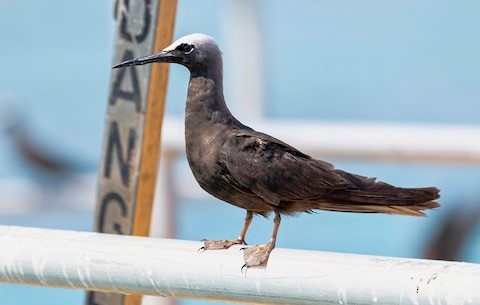
“Pacific Black Noddy,” A. m. minutus, with unusually pale, reddish legs. (Green Island National Park, Queensland, Australia; November 16, 2019.) © Jill Duncan & Ken Bissett
Immature “Atlantic” and “Pacific” resemble adults, but typically with a shorter bill and a white crown area that is usually smaller and uneven.
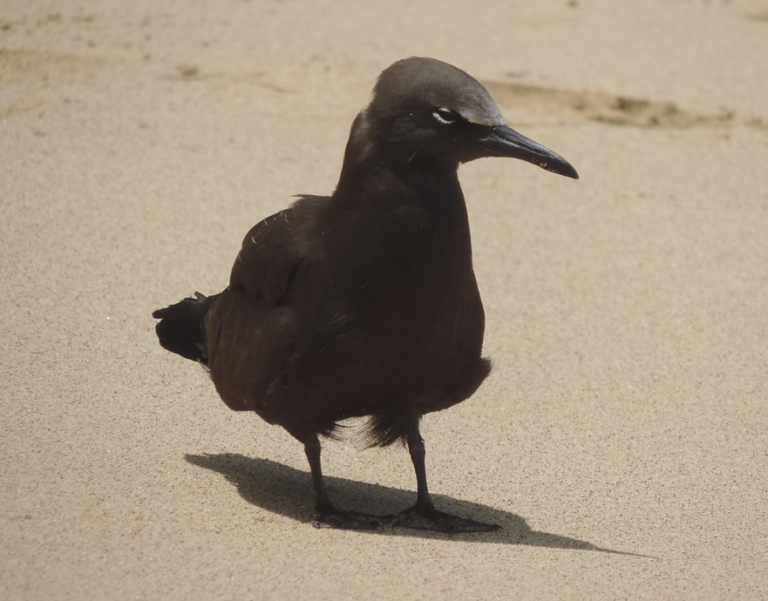
“Atlantic Black Noddy,” A. m. atlanticus, juvenile. (Fernando de Noronha, Brazil; March 21, 2015.) © Celine Philipp
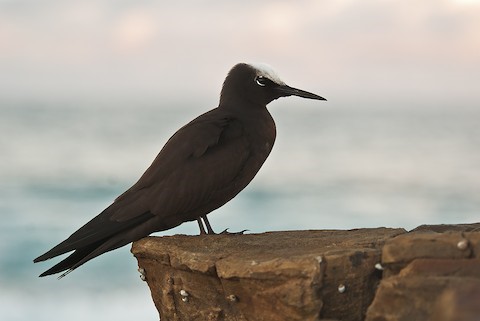
“Pacific Black Noddy,” A. m. minutus, immature. (Long Reef Aquatic Reserve, Collaroy, New South Wales, Australia; April 17, 2010.) © Dena Paris
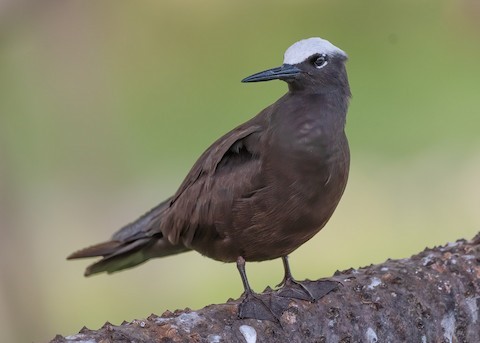
“Pacific Black Noddy,” A. m. minutus, immature. (Lady Elliot Island, Queensland, Australia; March 14, 2020.) © Barry Deacon
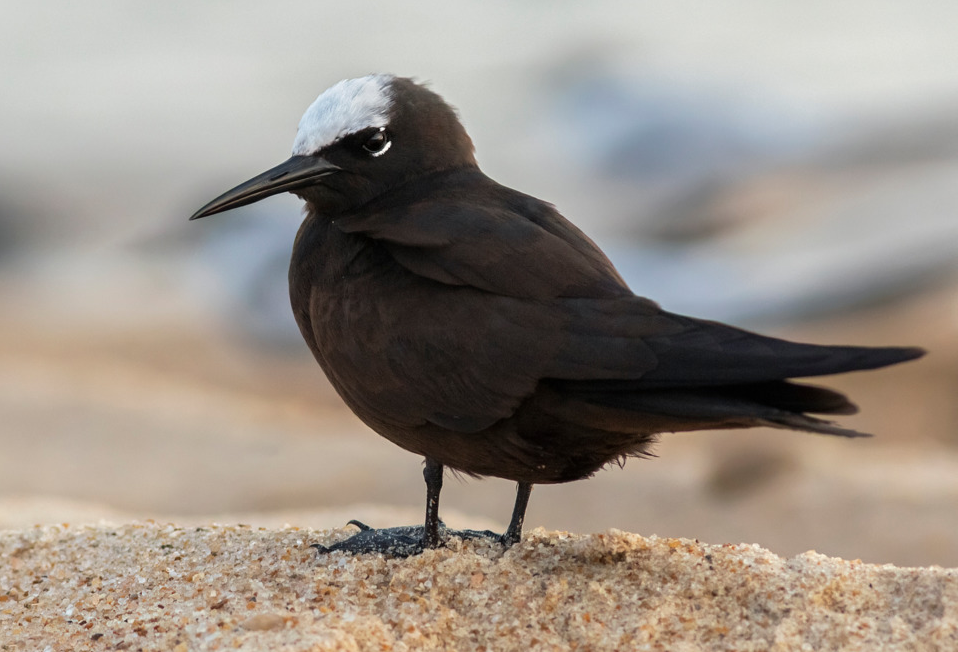
“Atlantic Black Noddy,” A. m. atlanticus, immature. (São Gonçalo do Amarante, Ceará, Brazil; November 24, 2018.) © Thiago Toledo

“Pacific Black Noddy,” A. m. minutus, apparently an immature with pinkish legs. (Flat Rock, Ballina, New South Wales, Australia; December 19, 2020.) © Hans Wohlmuth

“Pacific Black Noddy,” A. m. minutus, immature. (Heron Island, Queensland, Australia; February 24, 2018.) © Zhang Shen
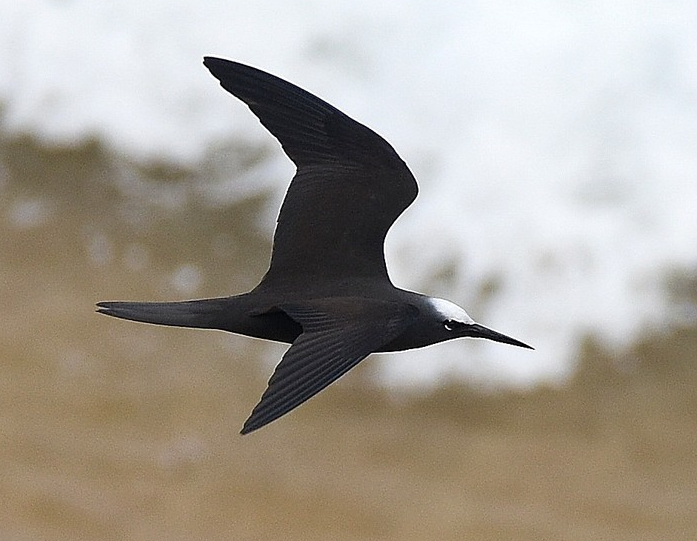
“Atlantic Black Noddy,” A. m. atlanticus, frontal. (Fernando de Noronha, Brazil; March 21, 2017.) © Rogério de Castro

“Atlantic Black Noddy,” A. m. atlanticus. (Fernando de Noronha, Brazil; September 12, 2018.) © Guto Balieiro
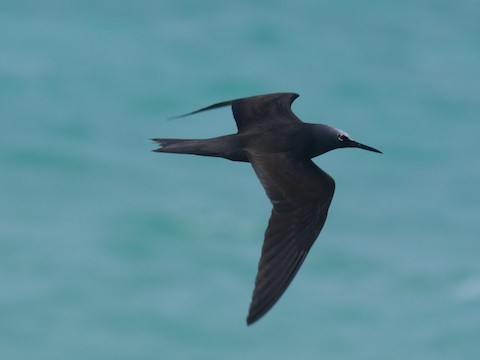
“Pacific Black Noddy,” A. m. minutus. (Heron Island, Queensland, Australia; December 9, 2020.) © Frank Coman
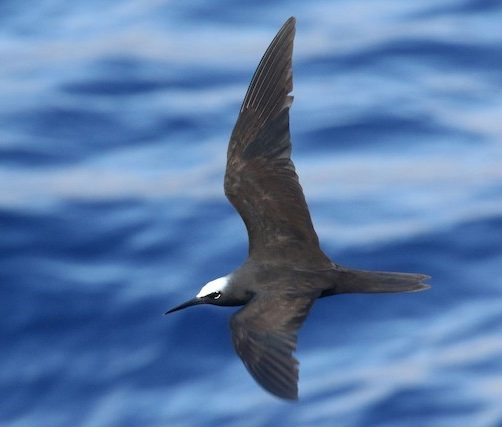
“Atlantic Black Noddy,” A. m. atlanticus. (Boatswain Bird Island, Ascension; April 5, 2018.) © Noah Strycker

“Pacific Black Noddy,” A. m. minutus. (Flat Rock, Ballina, New South Wales, Australia; March 4, 2018.) © Steven McBride

“Atlantic Black Noddy,” A. m. atlanticus, frontal. (Fernando de Noronha, Brazil; March 21, 2017.) © Rogério de Castro
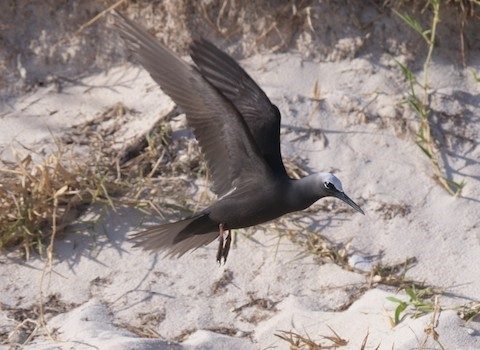
“Pacific Black Noddy,” A. m. minutus. (Heron Island, Queensland, Australia; December 11, 2020.) © Frank Coman
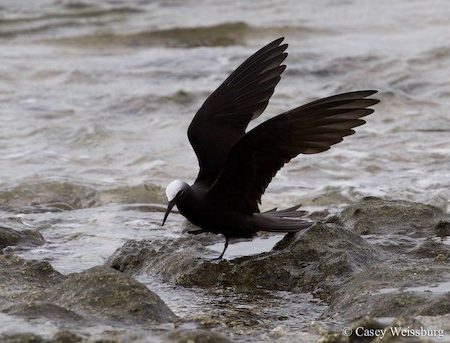
“Pacific Black Noddy,” A. m. minutus. (Ta’u, American Samoa; February 10, 2017.) © Casey Weissburg

“Pacific Black Noddy,” A. m. minutus. (Nukuloa, Wallis and Futuna; August 16, 2015.) © Thierry Nogaro
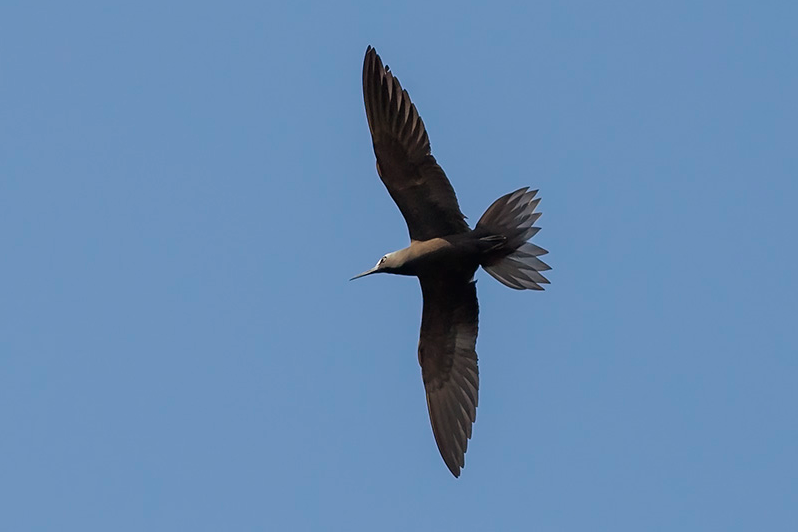
“Atlantic Black Noddy,” A. m. atlanticus, in flight, ventral view. (Fernando de Noronha, Brazil; October 6, 2016.) © Marco Guedes

“Atlantic Black Noddy,” A. m. atlanticus, showing shapes of spread tail and wings. (Fernando de Noronha, Brazil; June 6, 2013.) © Caio Brito

“Pacific Black Noddy,” A. m. minutus. (Bora Bora, French Polynesia; November 17, 2013.) © Geoff Dennis
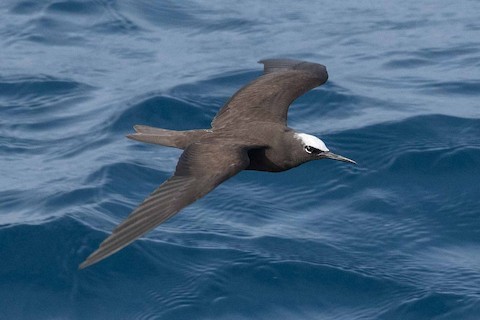
“Pacific Black Noddy,” A. m. marcusi, immature. (Offshore from French Frigate Shoals, Hawaii; April 3, 2020.) © Eric VanderWerf

“Pacific Black Noddy,” A. m. minutus, immature. (Flat Rock, Ballina, New South Wales, Australia; December 19, 2020.) © Hans Wohlmuth
“Hawaiian Noddy”. Similar to other Black Noddies, but has a somewhat shorter bill, extensively pale-gray head and tail, browner wings, and orange feet (at least on adults, sometimes dull but more typically bright-orange).
Adult “Hawaiians” usually appear mostly gray on the head, neck, rump, and tail, with darker, blackish-brown wings and back.
The gray rump and tail often appear quite pale. The gray on the head is typically paler on the crown and nape, and gradually transitions to darker shades around the mantle and the sides of the neck.
The wings appear more blackish when freshly molted and become browner with wear.
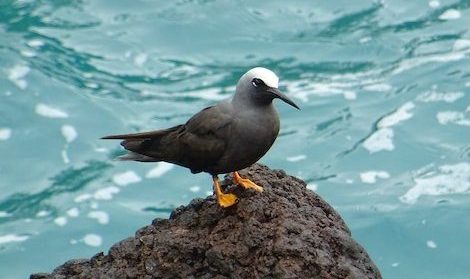
“Hawaiian Noddy,” A. m. melanogenys, showing vivid orange feet. (Wai’anapanapa State Park, Maui, Hawaii; August 12, 2018.) © Pablo Pascual
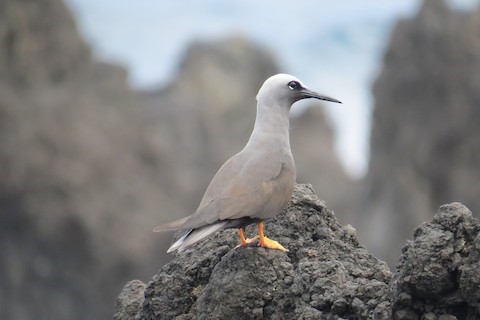
“Hawaiian Noddy,” A. m. melanogenys, appearing pale due to the lighting, and showing typically orange feet. (Wai’anapanapa State Park, Maui, Hawaii; March 10, 2016.) © Myron Gerhard
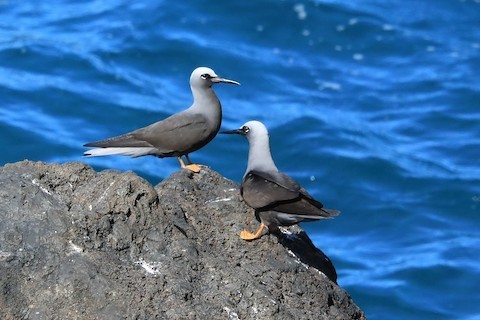
“Hawaiian Noddy,” A. m. melanogenys. (Wai’anapanapa State Park, Maui, Hawaii; March 26, 2019.) © Linda Kavanaugh

“Hawaiian Noddy,” A. m. melanogenys. (Wai’anapanapa State Park, Maui, Hawaii; November 2, 2020.) © John Sullivan
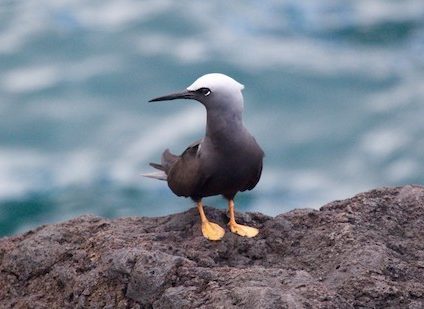
“Hawaiian Noddy,” A. m. melanogenys, showing vivid orange feet. (Wai’anapanapa State Park, Maui, Hawaii; January 22, 2016.) © Michael Hooper

“Hawaiian Noddy,” A. m. melanogenys, appearing exceptionally pale on the tail and head. (Wai’anapanapa State Park, Maui, Hawaii; January 22, 2016.) © Michael Hooper
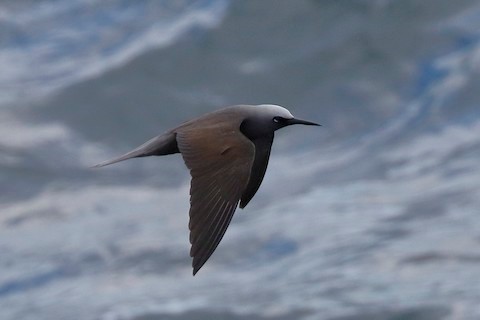
“Hawaiian Noddy,” A. m. melanogenys. (Coastal Chain of Craters Road, Hawaii Volcanoes National Park, Big Island, Hawaii; March 27, 2018.) © Sharif Uddin
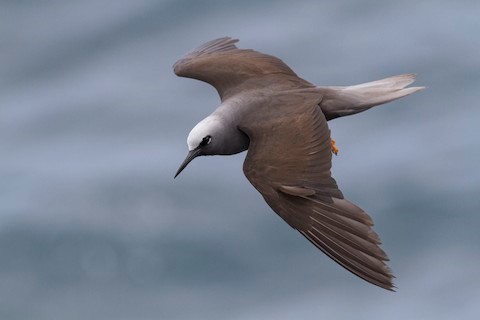
“Hawaiian Noddy,” A. m. melanogenys—note the partly visible orange foot. (Coastal Chain of Craters Road, Hawaii Volcanoes National Park, Big Island, Hawaii; July 4, 2016.) © Jacob Drucker
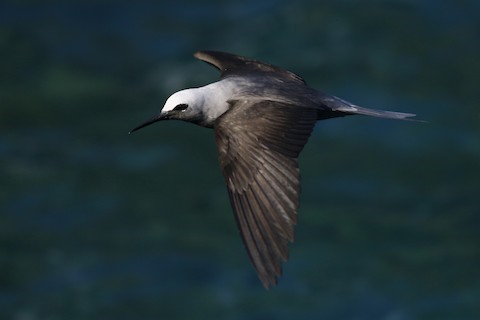
“Hawaiian Noddy,” A. m. melanogenys, with wings appearing blackish. (Wai’anapanapa State Park, Maui, Hawaii; November 2, 2020.) © John Sullivan

“Hawaiian Noddy,” A. m. melanogenys, showing strong contrast between blackish wings and pale-gray crown and tail. (Coastal Chain of Craters Road, Hawaii Volcanoes National Park, Big Island, Hawaii; April 6, 2016.) © Michael Pang
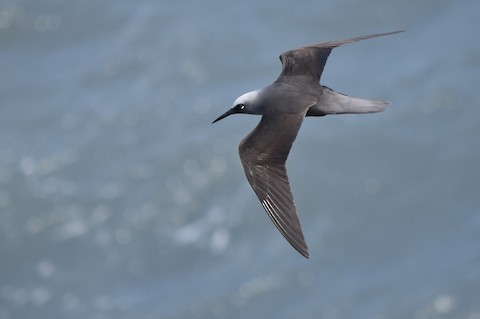
“Hawaiian Noddy,” A. m. melanogenys, with wings appearing blackish. (Coastal Chain of Craters Road, Hawaii Volcanoes National Park, Big Island, Hawaii; April 6, 2016.) © Michael Pang
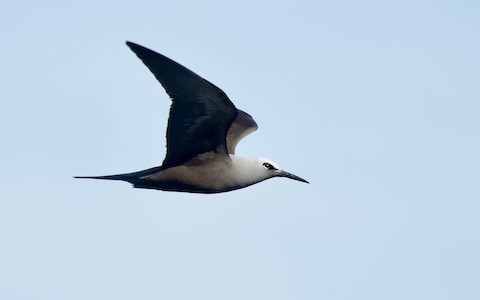
“Hawaiian Noddy,” A. m. melanogenys, appearing exceptionally pale in this lighting. (Lihua Islet, Hawaii; April 17, 2019.) © Lizabeth Southworth
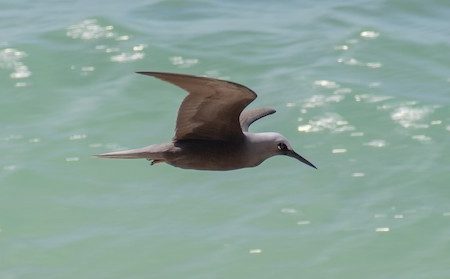
“Hawaiian Noddy,” A. m. melanogenys, appearing mostly pale in this lighting, and showing mostly grayish underparts. (Napili-Honokowai, Maui, Hawaii; March 6, 2020.) © Maxwell Ramey
Immature “Hawaiians” are darker than adults, blackish-brown overall with a partly whitish crown and dark feet. Unlike adults, their rumps and tails are typically concolor with the back.
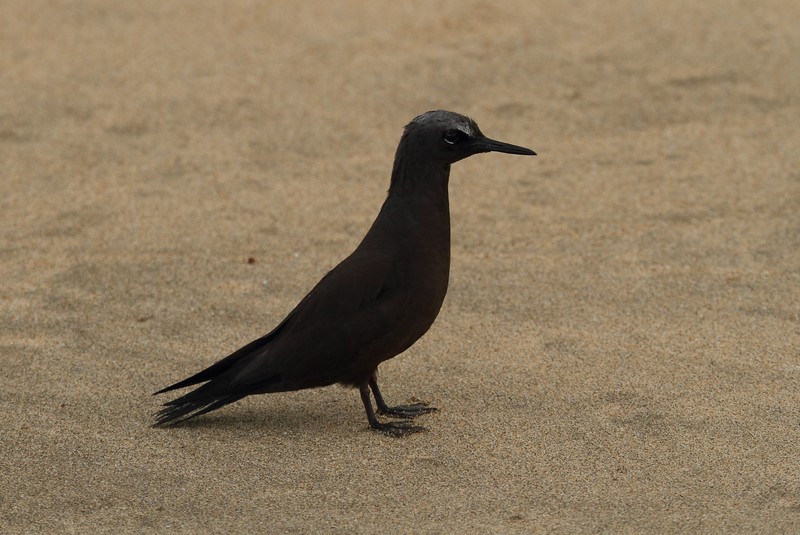
“Hawaiian Noddy,” A. m. melanogenys, juvenile—essentially all-dark, including the crown and the feet. (Kalalau Beach, Na Pali Coast State Park, Kauai, Hawaii; June 14, 2015.) © Patrick J. Blake

“Hawaiian Noddy,” A. m. melanogenys, immature. (Kekaha Beach Park, Kauai, Hawaii; April 5, 2016.) © Jacob Drucker

“Hawaiian Noddy,” A. m. melanogenys, immature. (Kekaha Beach Park, Kauai, Hawaii; April 5, 2016.) © Jacob Drucker
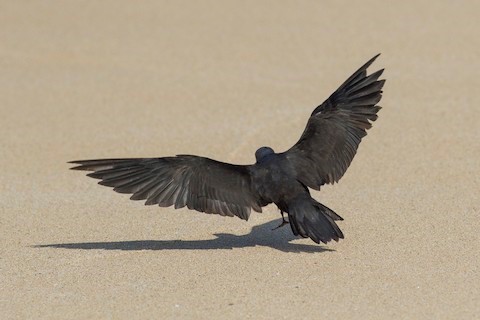
“Hawaiian Noddy,” A. m. melanogenys, immature. (Kekaha Beach Park, Kauai, Hawaii; April 5, 2016.) © Jacob Drucker
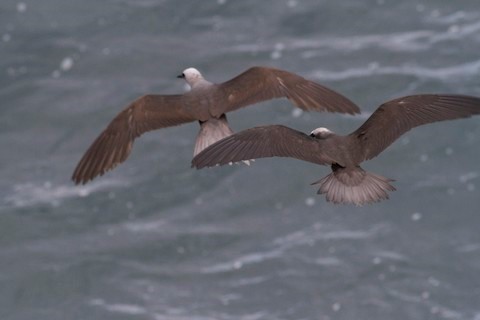
“Hawaiian Noddy,” A. m. melanogenys, apparently an adult and a subadult—based on its somewhat darker tail. (Coastal Chain of Craters Road, Hawaii Volcanoes National Park, Big Island, Hawaii; July 4, 2016.) © Jacob Drucker
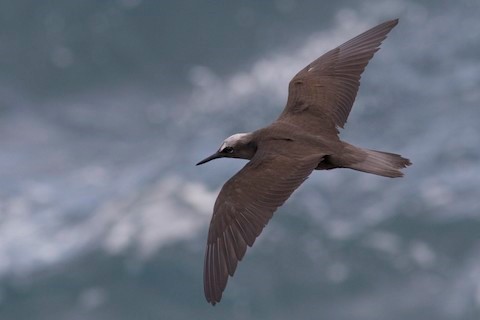
“Hawaiian Noddy,” A. m. melanogenys, immature showing some white on the crown and a subtly pale tone on the tail. (Coastal Chain of Craters Road, Hawaii Volcanoes National Park, Big Island, Hawaii; July 4, 2016.) © Jacob Drucker

An apparent “Pacific Black Noddy,” A. m. marcusi (or possibly a subadult “Hawaiian”) in a “Hawaiian Noddy” breeding colony—note the dark feet and strongly contrasting white crown compared to the orange feet and pale-gray hood of the adult “Hawaiian” below it. (Wai’anapanapa State Park, Maui, Hawaii; May 24, 2017.) © Nancy Christensen
At some stages in their development, many immature “Hawaiians” may be effectively indistinguishable from “Pacific Black”, which complicates analysis of the relationship between these forms.

“Hawaiian Noddy,” A. m. melanogenys, with dark feet—apparently a subadult. (Holei Sea Arch, Hawaii Volcanoes National Park, Big Island, Hawaii; September 4, 2019.) © Dean LaTray
Cf. Brown Noddy. Brown Noddy is so widespread that it occurs essentially throughout the ranges of all other noddies. Most noddy identification consists of distinguishing Brown from the relevant member(s) of the Black Noddy complex.
In most cases, “Atlantic” and “Pacific Black Noddies” are uniformly blackish and have a smaller, more crisply demarcated white crown area than Brown Noddy. However, in worn plumage and harsh lighting Black Noddies can appear brown and their crowns can appear more diffuse. Brown Noddy’s crown coloration also varies somewhat with factors that include molt-stage and lighting. When general coloration and crown demarcation are inconclusive, there are potentially more objective differences in overall structure, bill size and shape, and wing contrast.
Structure: Black is somewhat smaller and more buoyant (tern-like) in flight. Conversely, Brown is bulkier and more gull-like. Although the proportions between their wing and tail measurements are similar, Brown’s average about 15% longer and, when seen in flight, its tail feathers often create the impression of being disproportionately long.
Bill Size and Shape: Black’s bill is appreciably thinner and straighter—or, in other words, Brown’s bill is thicker and more noticeably curved. Black’s bill averages longer while the rest of its head is smaller than Brown’s. In most postures, Black’s eye appears “off-centered”—closer to the back of its head than to the tip of its bill—whereas Brown’s eye is about equidistant from the back of its head and the tip of its bill.

“Atlantic Black Noddy,” A. m. atlanticus (foreground) with Brown Noddy, showing differences in size, general coloration, and demarcation of white crown—note that the Brown Noddy appears much larger in the frame even though it is farther from the camera. (São Pedro e São Paulo, Brazil; November 24, 2018.) © Ronald Santiago
Wing Contrast: Black’s wings are usually darker than Brown’s, and nearly uniform on the upperside, with little contrast between the coverts and flight feathers—whereas Brown’s wings typically appear two-toned: brown on the coverts versus darker, more blackish on the adjacent flight feathers.
Cf. Lesser Noddy. The Lesser Noddy was traditionally considered a subspecies of Black Noddy, but it is widely recognized as a separate species. Lesser has distinctive features that differentiate it from the “Pacific Black Noddies” that occur with it in the eastern Indian Ocean, and from the “Atlantic Black Noddy”, which could potentially occur in South African waters. Lesser typically has a longer bill and more extensive gray on the head and neck. In particular, Lesser has pale lores—noticeable at a distance as Lesser’s eye appears as an isolated dark patch on a mostly pale face.

Lesser Noddy, showing pale-gray lores. (West Island, Ashmore Reef, Western Australia; April 29, 2019.) © Magen Pettit
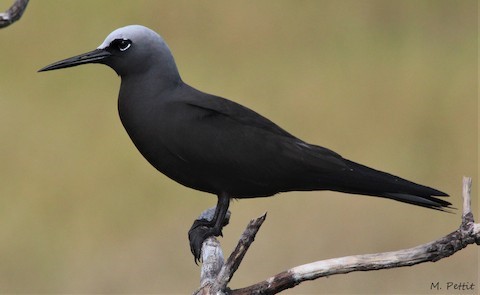
“Pacific Black Noddy,” A. m. minutus, showing black lores. (West Island, Ashmore Reef, Western Australia; April 29, 2019.) © Magen Pettit
Notes
Polytypic species consisting of seven recognized subspecies that are divided into three distinct forms, perhaps more appropriately classified as two or three species: “Atlantic Black Noddy” (americanus and atlanticus); “Pacific Black Noddy” (minutus, marcusi, worcesteri, and diamesus); and “Hawaiian Noddy” (melanogenys).
A fourth form, the Lesser Noddy (A. tenuirostris), was traditionally regarded as conspecific (with all four forms together known collectively as either Black, White-capped, or Lesser Noddy, A. tenuirostris) but is generally acknowledged to be a separate species—as it is visually distinctive and apparently breeds alongside “Pacific Black Noddy” at Ashmore Reef without interbreeding.
Howell and Zufelt (2019) recognize each of the four forms as separate species. In addition to Lesser, it seems appropriate to classify “Hawaiian” as separate based on factors that include pronounced differences in plumage, leg color, and bill length, and their persistence as recognizably distinct despite overlapping ranges.
Assuming that both Lesser and “Hawaiian” are ultimately recognized as separate species, biogeographic logic would tend to imply that the other two forms, “Atlantic Black” and “Pacific Black”, should be presumptively separate as well—although they are very similar and might not be reliably distinguishable.
References
Alderfer, J., and J.L. Dunn. 2014. National Geographic Complete Birds of North America. National Geographic Society, Washington, D.C.
Ascanio, D., G.A. Rodriguez, and R. Restall. 2017. Birds of Venezuela. Christopher Helm, London.
BirdLife International. 2020. Anous minutus. The IUCN Red List of Threatened Species 2020: e.T22694799A163885644. https://dx.doi.org/10.2305/IUCN.UK.2020-3.RLTS.T22694799A163885644.en. (Accessed December 24, 2020.)
Bond, J. 1979. Birds of the West Indies (Fourth Edition). Collins, London.
eBird. 2020. eBird: An online database of bird distribution and abundance. Cornell Lab of Ornithology, Ithaca, N.Y. http://www.ebird.org. (Accessed December 24, 2020.)
Fagan, J., and O. Komar. 2016. Peterson Field Guide to the Birds of Northern Central America. Houghton Mifflin Harcourt, New York.
Harrison, P. 1983. Seabirds: An Identification Guide. Houghton Mifflin, Boston.
Howell, S.N.G., and S.W. Webb. 1995. A Guide to the Birds of Mexico and Northern Central America. Oxford University Press, Oxford.
Howell, S.N.G., and K. Zufelt. 2019. Oceanic Birds of the World. Princeton University Press.
Kirwan, G.M., A. Levesque, M. Oberle, and C.J. Sharpe. 2019. Birds of the West Indies. Lynx Edicions, Barcelona.
Lee, D.S., and W.A. Mackin. 2009. Black Noddy. West Indian Breeding Seabird Atlas, http://www.wicbirds.net/blno.html. (Accessed December 23, 2020.)
Pratt, H.D., P.L. Bruner, and D.G. Berrett. 1987. A Field Guide to the Birds of Hawaii and the Tropical Pacific. Princeton University Press.
Pratt, H.D. 1993. Enjoying Birds in Hawaii: A Birdfinding Guide to the Fiftieth State (Second Edition). Mutual Publishing, Honolulu, Hawaii.
Pyle, R.L., and P. Pyle. 2017. The Birds of the Hawaiian Islands: Occurrence, History, Distribution, and Status. Version 2 (January 1, 2017). http://hbs.bishopmuseum.org/birds/rlp-monograph/. B.P. Bishop Museum, Honolulu, Hawaii.
Raffaele, H., J. Wiley, O. Garrido, A. Keith, and J. Raffaele. 1998. A Guide to the Birds of the West Indies. Princeton University Press, Princeton, N.J.
van Perlo, B. 2002. Birds of Western and Central Africa. Princeton University Press.
van Perlo, B. 2009. A Field Guide to the Birds of Brazil. Oxford University Press.
Wells, J.V., and A.C. Wells. 2017. Birds of Aruba, Bonaire, and Curaçao. Cornell University Press.
Wikiaves. 2020. Trinta-réis-preto, https://www.wikiaves.com.br/wiki/trinta-reis-preto. (Accessed December 23, 2020.)
